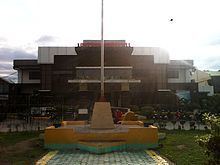Country Philippines Founded August 14, 1959 Time zone PST (UTC+8) | Barangays Area 221.8 km² | |
 | ||
Neighborhoods Tibal-og, Brgy Libertad, Maricris Village, Brgy Tulalian, Kinamayap, Brgy. New Visayas, Brgy Tibal-Og | ||
Sto. Tomas is a 1st class municipality in the province of Davao del Norte, Philippines. According to the 2015 census, it has a population of 118,750 people.
Contents
- Map of Santo Tomas Davao del Norte Philippines
- Etymology
- History
- Geography
- Barangays
- Climate
- Demographics
- Economy
- Transportation
- Education
- Celebrations
- References
Map of Santo Tomas, Davao del Norte, Philippines
Etymology
Sto. Tomas was so named after Saint Thomas, the patron saint of Danao which is the hometown of the late governor of undivided Davao Province Vicente Duterte, father of the 16th Philippine president Rodrigo Duterte.
History
What is now Sto. Tomas, initially called Tibal-og, was once part of the jurisdiction of nearby town of Kapalong. Before the 1950s. the place used to be a lush forest inhabited by the indigenous Ata-Manobo people.
According to the town's pioneering residents, the area of what is now Kapalong (in which what is now Sto. Tomas was still part of) and Panabo City were planted for abaca during the pre-war years.
After the founding of Sto. Tomas as a municipality, it continued to grow and prosper, even as it went several successions of mayoralty governance throughout its history.
Geography
Sto. Tomas is located on the island of Mindanao, and it is in the province's second political district. It is bounded in the north by the Municipalities of Kapalong and Talaingod, in the east by the Municipality of Asuncion, in the west by Davao City, and in the south by the Municipality of Braulio E. Dujali.
Barangays
Sto. Tomas is politically subdivided into 19 barangays.
Climate
Rainfall in Sto. Tomas is evenly distributed throughout the year. Being a nearly typhoon-free municipality, the production of high value crops is favorable all year round and makes a profitable investment.
Demographics
Sto. Tomas is home to a diverse culture inter-mingling with Mandaya and Ata-Manobo. The people are predominantly Cebuano.
Economy
Significant to the economic development of Sto. Tomas is a number of multi-national corporations and cooperatives engaged in banana based commercial production successfully operating in the municipality. Rice production also contributes to the economic development of the municipality.
Transportation
Sto. Tomas sits astride the Davao del Norte Provincial Circumferential Road. It is more or less 30 kilometres (19 mi) or about an hour ride from Tagum City by any land vehicle, and the town offers a wide choice of public utility jeepneys via Kinamayan route or bus liners via Carmen route. Davao City is approximately 63 kilometres (39 mi) or an hour and a half ride by bus or private car.
Sto. Tomas is accessible by land through any type of vehicle. There are tricycle units serving the different routes within the municipality. Most tricycles are color-coded red, with a capacity of 6 passengers per tricycle.
Education
Sto. Tomas have several public and private institutions.
Elementary schools:
High schools:
Tertiary education:
Technical/vocational schools:
Celebrations
Araw ng Sto. Tomas (lit. Day of Sto. Tomas) is a celebration held every 14th of August annually. Events include drum and lyre competitions; parades, fireworks display, and many more.
